Unit 5
QUANTUM PHYSICS
Q1) Explain dual nature of matter?
Solution: As we know in the Photoelectric Effect, the Compton Effect, and the pair production effect—radiation exhibits particle-like characteristics in addition to its wave nature. In 1923 de Broglie took things even further by suggesting that this wave–particle duality is not restricted to radiation, but must be universal.
In 1923, the French physicist Louis Victor de Broglie (1892-1987) put forward the bold hypothesis that moving particles of matter should display wave-like properties under suitable conditions.
All material particles should also display dual wave–particle behaviour. That is, the wave–particle duality present in light must also occur in matter.
So, starting from the momentum of a photon p = hν/c = h/λ.
We can generalize this relation to any material particle with nonzero rest mass. Each material particle of momentum  behaves as a group of waves (matter waves) whose wavelength λ and wave vector
behaves as a group of waves (matter waves) whose wavelength λ and wave vector  aregoverned by the speed and mass of the particle. De Broglie proposed that the wave length λ associated with a particle of momentum p is given as where m is the mass of the particle and v its speed.
aregoverned by the speed and mass of the particle. De Broglie proposed that the wave length λ associated with a particle of momentum p is given as where m is the mass of the particle and v its speed.
λ =  =
= …….(1)
…….(1)  =
=  …….(2)
…….(2)
Where ℏ = h/2π. The expression known as the deBroglie relation connects the momentum of a particle with the wavelength and wave vector of the wave corresponding to this particle. The wavelength λ of the matter wave is called de Broglie wavelength. The dual aspect of matter is evident in the de Broglie relation.
λ is the attribute of a wave while on the right hand side the momentum p is a typical attribute of a particle. Planck’s constant h relates the two attributes. Equation (1) for a material particle is basically a hypothesis whose validity can be tested only by experiment.
However, it is interesting to see that it is satisfied also by a photon. For a photon, as we have seen, p = hν/c.
Therefore
 =
=  = λ
= λ
Q2) What is the de Broglie wavelength associated with (a) an electron moving with a speed of 5.4×106 m/s, and (b) a ball of mass 150 g travelling at 30.0 m/s?
Solution: (a)For the electron:
Mass m = 9.11×10–31 kg, speed v = 5.4×106 m/s.
Then, momentum
p = m v = 9.11×10–31 kg × 5.4 × 106 (m/s)
p = 4.92 × 10–24 kg m/s
de Broglie wavelength, λ = h/p = 6.63 x 10-34Js/ 4.92 × 10–24kg m/s
λ= 0.135 nm
(b)For the ball:
Mass m’ = 0.150 kg,
Speed v ’= 30.0 m/s.
Then momentum p’ = m’ v’= 0.150 (kg) × 30.0 (m/s)
p’= 4.50 kg m/s
de Broglie wavelength λ’ = h/p’ =6.63 x 10-34Js/ 4.50kg m/s =1.47 ×10–34 m
The de Broglie wavelength of electron is comparable with X-raywavelengths. However, for the ball it is about 10–19 times the size of the proton, quite beyond experimental measurement.
Q3) What is the de Broglie wavelength associated with an electron, accelerated through a potential difference of 100 volts?
Solution: Accelerating potential V = 100 V. The de Broglie wavelength λ is
λ= h /p = 1 227/ nm
nm
λ.1 227/ nm = 0.123 nm
nm = 0.123 nm
The de Broglie wavelength associated with an electron in this case is ofthe order of x ray wavelengths.
Q4) What is Heisenberg’s Uncertainty Principle?
Solution: According to classical physics, given the initial conditions and the forces acting on a system, the future behaviour (unique path) of this physical system can be determined exactly. That is, if the initial coordinates ,velocity
,velocity , and all the forces acting on the particle are known, the position
, and all the forces acting on the particle are known, the position , and velocity
, and velocity are uniquely determined by means of Newton’s second law. So by Classical physicsit can be easily derived.
are uniquely determined by means of Newton’s second law. So by Classical physicsit can be easily derived.
Does this hold for the microphysical world?
Since a particle is represented within the context of quantum mechanics by means of a wave function corresponding to the particle’s wave, and since wave functions cannot be localized, then a microscopic particle is somewhat spread over space and, unlike classical particles, cannot be localized in space. In addition, we have seen in the double-slit experiment that it is impossible to determine the slit that the electron went through without disturbing it. The classical concepts of exact position, exact momentum, and unique path of a particle therefore make no sense at the microscopic scale. This is the essence of Heisenberg’s uncertainty principle.
In its original form, Heisenberg’s uncertainty principle states that: If the x-component of the momentum of a particle is measured with an uncertainty ∆px, then its x-position cannot, at the same time, be measured more accurately than ∆x =ℏ/(2∆px). The three-dimensional form of the uncertainty relations for position and momentum can be written as follows:

This principle indicates that, although it is possible to measure the momentum or positionof a particle accurately, it is not possible to measure these two observables simultaneously toan arbitrary accuracy. That is, we cannot localize a microscopic particle without giving to ita rather large momentum.
We cannot measure the position without disturbing it; there is noway to carry out such a measurement passively as it is bound to change the momentum.
To understand this, consider measuring the position of a macroscopic object (you can consider a car) and the position of a microscopic system (you can consider an electron in an atom). On the one hand, to locate the position of a macroscopic object, you need simply to observe it; the light that strikes it and gets reflected to the detector (your eyes or a measuring device) can in no measurable way affect themotion of the object.
On the other hand, to measure the position of an electron in an atom, youmust use radiation of very short wavelength (the size of the atom). The energy of this radiation is high enough to change tremendously the momentum of the electron; the mere observation of the electron affects its motion so much that it can knock it entirely out of its orbit.
It is therefore impossible to determine the position and the momentum simultaneously to arbitrary accuracy. If a particle were localized, its wave function would become zero everywhere else and its wave would then have a very short wavelength.
Q5) The uncertainty in the momentum of a ball travelling at 20m/s is 1×10−6 of its momentum. Calculate the uncertainty in position? Mass of the ball is given as 0.5kg.
Solution:
Given
v = 20m/s,
m = 0.5kg,
h = 6.626 × 10-34 m2 kg / s
Δp =p×1×10−6
As we know that,
P = m×v = 0.5×20 = 10kgm/s
Δp = 10×1×10−6
Δp = 10-5
Heisenberg Uncertainty principle formula is given as,
∆x∆p
∆x 
∆x 
∆x =0.527 x 10-29 m
Q6) Prove non-existence of electrons in the nucleus?
Solution: One of the applications is to prove that electron cannot exist inside the nucleus. But to prove it, let us assume that electrons exist in the nucleus.
As the radius of the nucleus in approximately 10-14m. If electron is to exist inside the nucleus, then uncertainty in the position of the electron is given by
According to uncertainty principle
∆x∆p =h/2π
Thus ∆p=h/2π∆x
Or ∆p=6.62 x10-34/2 x 3.14 x 10-14
Or ∆p=1.05 x 10-20 kg m/ sec
If this is p the uncertainty in the momentum of electron then the momentum of electron should be at least of this order that is p=1.05*10-20 kg m/sec.
An electron having this much high momentum must have a velocity comparable to the velocity of light. Thus, its energy should be calculated by the following relativistic formula
E = 

Therefore, if the electron exists in the nucleus, it should have an energy of the order of 19.6 MeV.
However, it is observed that beta-particles (electrons) ejected from the nucleus during b –decay have energies of approximately 3 Me V, which is quite different from the calculated value of 19.6 MeV.
Another reason that electron cannot exist inside the nucleus is that experimental results show that no electron or particle in the atom possess energy greater than 4 MeV.
Therefore, it is confirmed that electrons do not exist inside the nucleus.
Q7) Discuss applications of Heisenberg uncertainty principle?
Solution:
The Heisenberg uncertainty principle based on quantum physics explains a number of facts which could not be explained by classical physics.
One of the applications is to prove that electron cannot exist inside the nucleus.
But to prove it, let us assume that electrons exist in the nucleus.
As the radius of the nucleus in approximately 10-14m. If electron is to exist inside the nucleus, then uncertainty in the position of the electron is given by
According to uncertainty principle
∆x∆p =h/2π
Thus ∆p=h/2π∆x
Or ∆p=6.62 x10-34/2 x 3.14 x 10-14
Or ∆p=1.05 x 10-20 kg m/ sec
If this is p the uncertainty in the momentum of electron then the momentum of electron should be at least of this order that is p=1.05*10-20 kg m/sec.
An electron having this much high momentum must have a velocity comparable to the velocity of light. Thus, its energy should be calculated by the following relativistic formula
E = 
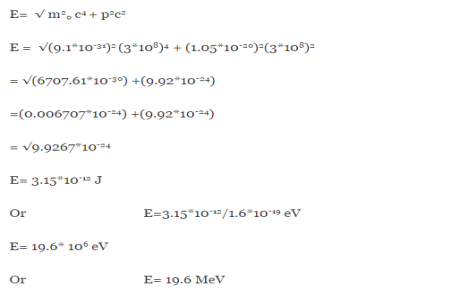
Therefore, if the electron exists in the nucleus, it should have an energy of the order of 19.6 MeV.
However, it is observed that beta-particles (electrons) ejected from the nucleus during b –decay have energies of approximately 3 Me V, which is quite different from the calculated value of 19.6 MeV.
Another reason that electron cannot exist inside the nucleus is that experimental results show that no electron or particle in the atom possess energy greater than 4 MeV.
Therefore, it is confirmed that electrons do not exist inside the nucleus.
2. Calculation of zero point energy
The minimum energy of a system at o k (zero kelvin) is called zero point energy.
Consider a particle which is confined to move under the influence of potential of dimensions a. Since the particle may be present anywhere in these dimensions, so uncertainty in position
∆x = a/2 (half the diameter).
According to uncertainty principle
∆x∆px = ℏ/2
or
Thus ∆px=ℏ/2∆x
∆px=ℏ/2a/2 = ℏ/a
Uncertainty in momentum of particle along x-axis is
∆px=ℏ/a
Assuming the momentum of particle to be at least equal to uncertainty in it, the lowest possible value of K.E. of particle is given by
K.E. = =
=  =
=
Where m is the mass of the particle.
Energy even at OK is given by the above equation. This minimum energy is called the zero-point energy.
This implies that even at zero kelvin, the particle is never at rest. If it is so, then ∆pX = 0, which is not possible. [It gives ∆x =∞]
3. Existence of proton, neutron and alpha particles within the nucleus.
We know that the rest mass of the protons and neutron is of the order of
1.67x 10-27 kg. Hence, the value of momentum 5.27 x 10-21kg.m/sec from calculation and also the value of v come out to be 3x 105m/sec.
The corresponding value of kinetic energy of a neutron or a proton is
E= =
=  =8.33 x 10-15J =
=8.33 x 10-15J = eV
eV
 52.05 keV
52.05 keV
Since the rest mass of the a-particle is nearly four times the proton mass, therefore the alpha particle should have a minimum kinetic energy of one fourth of 52.05 keV, or about 13 keV. Since the energy carried by the protons or neutrons emitted by the nuclei are greater than 52 keV and for a-particle more than 13 keV, these particles can exist in the nuclei.
4. Size of Elementary cell in Phase space
We have studied in our previous class that state of a microsystem is defined by six variables – three are due to position and three due to momentum.
Hence, a system of N particles needs 6 N variables
If ∆ x and ∆px be the uncertainly in position and in momentum measurements then
∆ x ∆ px=  ;
;
Similarly ∆ y ∆ py=  ,
,
And ∆ z ∆ pz=  ,
,
Multiplying these three equations, we get
∆ x ∆ y ∆ z ∆ px∆ py∆ pz= ( )3 in the units (J3 S3).
)3 in the units (J3 S3).
The above product is called the volume of elementary cell in phase space.
So, volume of an elementary cell in phase space  10-101 units, (for quantum statistics) being
10-101 units, (for quantum statistics) being  .
.
5. Accurate limit of frequency of radiation emitted by an atom
Consider the radiation emitted from an excited atom. The energy of this atom will decrease when it emits one or more photons of characteristic frequency.
The average period between excitation of the atom and the release of energy is about 10-8seconds.
Thus, uncertainly in energy is
∆ E 
Or ∆ E  J
J
Or ∆ E  5.3 x 10-27 J
5.3 x 10-27 J
Frequency of light is uncertain by
∆ν =  =
=  Hz
Hz  0.8 x 107 Hz
0.8 x 107 Hz
As a result, the radiation from an excited atom does not have the noted precise frequency new ν - ∆ν andν + ∆ν.
Q8) Derive the Schrodinger wave equation?
Solution: Schrodinger wave equation, is the fundamental equation of quantum mechanics, same as the second law of motion is the fundamental equation of classical mechanics. This equation has been derived by Schrodinger in 1925 using the concept of wave function on the basis of de-Broglie wave and plank’s quantum theory.
Let us consider a particle of mass m and classically the energy of a particleis the sum of the kinetic and potential energies. We will assume that the potential is a function of only x.
So We have
E=K+V= mv2+V(x) =
mv2+V(x) = +V(x) ……….. (1)
+V(x) ……….. (1)
By de Broglie’s relation we know that all particles can be represented as waves with frequency ω and wave number k, and that E= ℏω and p= ℏk.
Using this equation (1) for the energy will become
ℏω =  +V(x) ……….. (2)
+V(x) ……….. (2)
A wave with frequency ω and wavenumber k can be written as usual as
ψ(x, t) =Aei(kx−ωt) ……….. (3)
the above equation is for one dimensional and for three dimensional we can write it as
ψ(r, t) =Aei(k·r−ωt) ……….. (4)
But here we will stick to one dimension only.
 =−iωψ⇒ ωψ=
=−iωψ⇒ ωψ= ……….. (5)
……….. (5)
 =−k2ψ ⇒k2ψ = -
=−k2ψ ⇒k2ψ = -  ……….. (6)
……….. (6)
If we multiply the energy equation in Eq. (2) byψ, and using(5) and (6) , weobtain
ℏ(ωψ) =  ψ+V(x)ψ⇒
ψ+V(x)ψ⇒  = -
= -  + V(x) ψ……….. (7)
+ V(x) ψ……….. (7)
This is the time-dependent Schrodinger equation.
If we put the x and t in above equation then equation (7) takes the form as given below
 = -
= -  + V(x) ψ(x,t) ……….. (8)
+ V(x) ψ(x,t) ……….. (8)
In 3-D, thexdependence turns into dependence on all three coordinates (x, y, z) and the term becomes∇2ψ.
term becomes∇2ψ.
The term |ψ(x)|2gives the probability of finding the particle at position x.
Let us again take it as simply a mathematical equation, then it’s just another wave equation. However We already know the solution as we used this function ψ(x, t) =Aei(kx−ωt) to produce Equations (5), (6) and (7)
But let’s pretend that we don’t know this, and let’s solve the Schrodinger equation as if we were given to us.As always, we will guess an exponential solution by looking at exponential behaviour in the time coordinate, our guess is ψ(x, t) =e−iωtf(x) putting this into Equation (7) and cancelling thee−iωt yields
 = -
= -  + V(x)f(x) ……….. (9)
+ V(x)f(x) ……….. (9)
We already know that E= . However ψ(x, t) is general convention to also use the letter ψ to denote the spatial part. So we will now replace f(x) with ψ(x)
. However ψ(x, t) is general convention to also use the letter ψ to denote the spatial part. So we will now replace f(x) with ψ(x)
Eψ = -  + V(x) ψ ……….. (10)
+ V(x) ψ ……….. (10)
This is called the time-independent Schrodinger equation.
The Schrodinger equation also known as Schrodinger’s wave equation is a partial differential equation that describes the dynamics of quantum mechanical systems by the wave function. The trajectory, the positioning, and the energy of these systems can be retrieved by solving the Schrodinger equation.
All of the information for a subatomic particle is encoded within a wave function. The wave function will satisfy and can be solved by using the Schrodinger equation. The Schrodinger equation is one of the fundamental axioms that are introduced in undergraduate physics.
Q9) The mass of an electron is 9.1×10–31 kg. Its uncertainty in velocity is 5.7×105 m/sec. Calculate uncertainty in its position?
Solution: Given m= 9×10–31
ΔV= 5.7×105 m/sec
Δx=?
h= 6.6×10–34 Joule-Sec.
Δx.Δv ≥h/4πm
Δx≥h/4πmΔv
≥6.6×10–34/9×3.14×9.1×10–31×5.7×105
≥ 0.010×10–8
≥ 1×10–10m
Q10) The mass of a ball is 0.15 kg & its uncertainty in position to 10–10m. What is the value of uncertainty in its velocity?
Solution: Given
m=0.15 kg.
h=6.6×10-34 Joule-Sec.
Δx = 10 –10 m
Δv=?
Δx.Δv ≥h/4πm
Δv≥h/4πmΔx
≥6.6×10-34/4×3.14×0.15×10–10
≥ 3.50×10–24m
Q11) The mass of a bullet is 10gm & uncertainty in its velocity is 5.25×10–26 cm/sec. Calculate the uncertainty in its position?
Solution: m=10 gm. h=6.6×10–27 erg-sec
Δv= 5.25×10–26 cm
Δx=?
Δx.Δv ≥h/4πm
Δx≥h/4πmΔv
≥6.6×10-34/4×3.14×10×5.25×10–26
≥ 0.10×10–2m
≥ 1×10–3 cm
Q12) List the conditions wave function should satisfy?
Solution: The wave function, at a particular time, contains all the information that anybody at that time can have about the particle. But the wave function itself has no physical interpretation. It is not measurable. However, the square of the absolute value of the wave function has a physical interpretation. We interpret |ψ(x,t)|2 as a probability density, a probability per unit length of finding the particle at a time t at position x.
The wave function ψ associated with a moving particle is not an observable quantity and does not have any direct physical meaning. It is a complex quantity. The complex wave function can be represented as
ψ(x, y, z, t) = a + ib
and its complex conjugate as
ψ*(x, y, z, t) = a – ib.
The product of wave function and its complex conjugate is
ψ(x, y, z, t)ψ*(x, y, z, t) = (a + ib) (a – ib) = a2 + b2
a2 + b2is a real quantity.
However, this can represent the probability density of locating the particle at a place in a given instant of time.
The positive square root of ψ(x, y, z, t) ψ*(x, y, z, t) is represented as |ψ(x, y, z, t)|, called the modulus of ψ. The quantity |ψ(x, y, z, t)|2 is called the probability. This interpretation is possible because the product of a complex number with its complex conjugate is a real, non-negative number.
We should be able to find the particle somewhere, we should only find it at one place at a particular instant, and the total probability of finding it anywhere should be one.
For the probability interpretation to make sense, the wave function must satisfy certain conditions.



 dx =1
dx =1
Only wave function with all these properties can yield physically meaningful result.
Q13) What is Physical significance of wave function?
Solution:
Q14) Discuss Particle in a One Dimensional Deep Potential Well
Solution: Let us consider a particle of mass ‘m’ in a deep well restricted to move in a one dimension (say x). Let us assume that the particle is free inside the well except during collision with walls from which it rebounds elastically.
The potential function is expressed as
V= 0 for 0 ………. (1)
………. (1)
V=  for x <0, x>L ………. (2)
for x <0, x>L ………. (2)
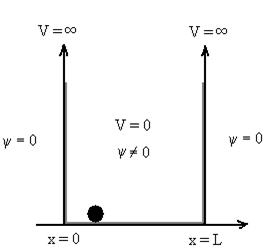
Figure : Particle in deep potential well
The probability of finding the particle outside the well is zero (i.e.Ѱ =0)
Inside the well, the Schrödinger wave equation is written as
 ψ +
ψ + Eψ =0 …………….(2)
Eψ =0 …………….(2)
Substituting E = k2 …………….(3)
E = k2 …………….(3)
writing the SWE for 1-D we get
 +k2ψ =0 …………….(4)
+k2ψ =0 …………….(4)
The general equation of above equation may be expressed as
ψ = Asin (kx + ϕ) …………….(5)
Where A and ϕ are constants to be determined by boundary conditions
Condition I: We have ψ = 0 at x = 0, therefore from equation
0= A sinϕ
As A  then sinϕ =0 orϕ=0 …………….(6)
then sinϕ =0 orϕ=0 …………….(6)
Condition II:Further ψ = 0 at x = L, andϕ=0,therefore from equation(5)
0= AsinkL
As A  then sinkL =0 orkL=nπ
then sinkL =0 orkL=nπ
k =  …………….(7)
…………….(7)
where n= 1,2,3,4………
Substituting the value of k from (7) to (3)
 )2 =
)2 =  E
E
This gives energy of level
En = n=1,2,3,4…so on …………….(8)
n=1,2,3,4…so on …………….(8)
From equation En is the energy value (Eigen Value) of the particle in a well.
It is clear that the energy values of the particle in well are discrete not continuous.
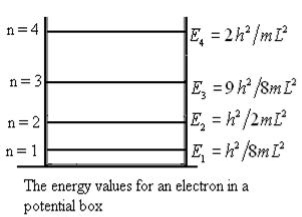
Using (6) and (7) equation (5) becomes, the corresponding wave functions will be
ψ =ψn= Asin …………….(9)
…………….(9)
The probability density
|ψ(x,t)|2 =ψψ*
|ψ(x,t)|2=A2sin2 …………….(10)
…………….(10)
The probability density is zero at x = 0 and x = L. since the particle is always within the well
 …………….(11)
…………….(11)


 =1
=1
A =
Substituting A in equation (9) we get
ψ =ψn=  sin
sin n=1,2,3,4….. …………….(12)
n=1,2,3,4….. …………….(12)
The above equation (12) is normalized wave function orEigen function belonging to energy value En
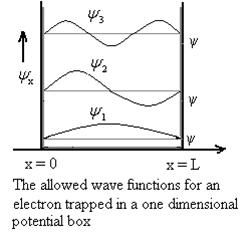
Figure: Wave function for Particle
Therefore, according to uncertainty principle it is difficult to assign a position to the electron.
Q15) A 45 kW broadcasting antenna emits radio waves at a frequency of 4 MHz.
(a) How many photons are emitted per second?
(b) Is the quantum nature of the electromagnetic radiation important in analyzing the radiation emitted from this antenna?
Solution: (a) The electromagnetic energy emitted by the antenna in one second is E = 45 000 J. Thus, the number of photons emitted in one second is

(b) Since the antenna emits a huge number of photons every second, 1.7 1031, the quantum nature of this radiation is unimportant. As a result, this radiation can be treated fairly accurately by the classical theory of electromagnetism.
1031, the quantum nature of this radiation is unimportant. As a result, this radiation can be treated fairly accurately by the classical theory of electromagnetism.
Q16) Consider a one-dimensional particle which is confined within the region 0  x
x a and whose wave function is (x, t) =sin(πx/a)exp-iωt.
a and whose wave function is (x, t) =sin(πx/a)exp-iωt.
(a) Find the potential V(x).
(b) Calculate the probability of finding the particle in the interval a/4  x
x  3a/4.
3a/4.
Solution: Since the first time derivative and the second x derivative of (x, t),are given by  =-iω (x, t) and
=-iω (x, t) and =-(π2/a2) (x, t)the Schrödinger equation yields
=-(π2/a2) (x, t)the Schrödinger equation yields
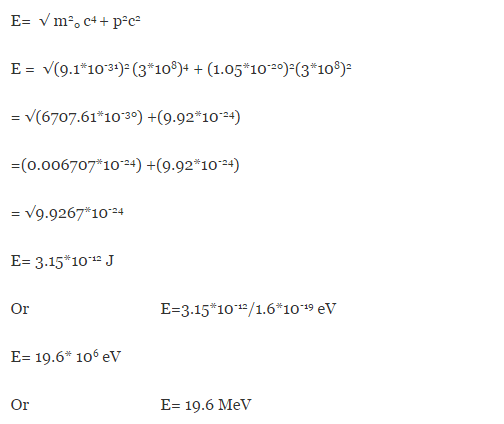
Hence V(x,t) is time independent and given by

(b) The probability of finding the particle in the interval a/4  x
x  3a/4.can be obtained from
3a/4.can be obtained from

Q17) Calculate the de Broglie wavelength of an electron having a kinetic energy of 1000 eV. Compare the result with the wavelength of x-rays having the same energy?
Solution: The kinetic energy
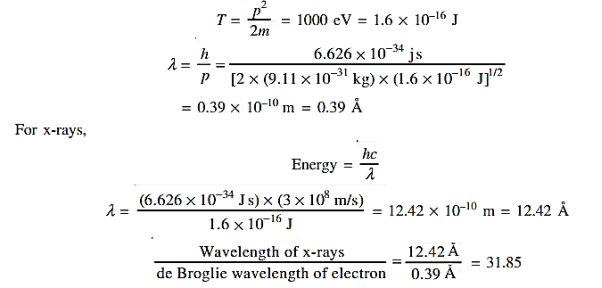
Q18) Determine the de Broglie wavelength of an electron that has been accelerated through a potential difference of (i) 100 V, (ii) 200 V.
Solution: (i)The energy gained by the electron = 100 eV. Then

Q19) The wave function of a particle of mass m moving in a potential V (x) is

where A and k are constants. Find the explicit form of the potential V (x).
Solution:

Substituting these values in the time dependent Schrödinger equation, we have

Q20) What is Compton effect ? Write result and conclusion of Compton experiment?
Solution: In his 1923 experiment, Compton provided the most conclusive confirmation of the particle aspect of radiation.
By scattering X-rays off free electrons, he found that the wavelength of the scattered radiation is larger than the wavelength of the incident radiation. This can be explained only by assuming that the X-ray photons behave like particles.
According to classical physics, the incident and scattered radiation should have the same wavelength.
Also we know that the energy of the X-ray radiation is too high to be absorbed by a free electron therefore the incident X-ray would then provide an oscillatory electric field which sets the electron into oscillatory motion, hence making it radiate light with the same wavelength but with an intensity I that depends on the intensity of the incident radiation I0
But neither of these two predictions of classical physics is compatible with experiment.
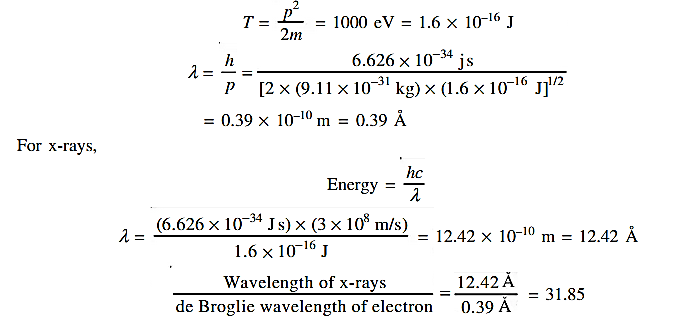
Figure: Elastic scattering of a photon from a free electron
By experiment Compton reveal that the wavelength of the scattered X-radiation increases by an amount  , called the wavelength shift, and that
, called the wavelength shift, and that  depends not on the intensity of the incident radiation, but only on the scattering angle.
depends not on the intensity of the incident radiation, but only on the scattering angle.
Compton succeeded in explaining his experimental results only after treating the incident radiation as a stream of particles—photons—colliding elastically with individual electrons.
Here we will discuss elastic scattering of a photon from a free electron as shown in figure. Consider that the incident photon, of energy E =hνand momentum p = hν /c, collides with an electron that is initially at rest. If the photon scatters with a momentum at an angle θ while the electron recoils with a momentum
at an angle θ while the electron recoils with a momentum  the conservation of linear momentum yields
the conservation of linear momentum yields
 =
=  +
+  …………(1)
…………(1)
Which leads
 = (
= ( -
-  )2=
)2=  +
+  -2pp’cosθ =
-2pp’cosθ =  (
(  +
+  -2νν’cosθ) ………..(2)
-2νν’cosθ) ………..(2)
Energy Conservation
The energies of the electron before and after the collision are given, respectively, by
E0 =mec2 ………..(3)

Since the energies of the incident and scattered photons are given by E = hνand E0 = hν’, respectively, conservation of energy dictates that
E + E0 = E’ + Ee ………..(4) ………..(5)
………..(5)
Which leads to
 ………..(6)
………..(6)
Squaring both sides of (5) and simplifying, we get
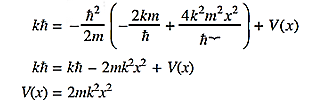
Hence wavelength shift is given by
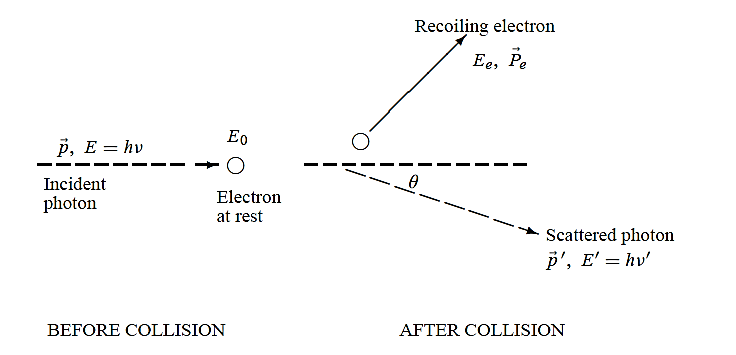
Where λC = h/mec =2.426 x 10-12 m is called the Compton wavelength of the electron.
This relation connects the initial and final wavelengths to the scattering angle.
Compton’s experimental observation:
Q21) High energy photons are scattered from electrons initially at rest. Assume the photons are back scattered and their energies are much larger than the electron’s rest-mass energy, E = mec2.
(a) Calculate the wavelength shift.
(b) Show that the energy of the scattered photons is half the rest mass energy of the electron, regardless of the energy of the incident photons.
(c) Calculate the electron’s recoil kinetic energy if the energy of the incident photons is 150 MeV.
Solution:
(a) In the case where the photons backscatter i.e.θ = π
The wavelength shift becomes
 =
=  -
-  = 2
= 2 csin2θ = 2
csin2θ = 2 csin2π = 2
csin2π = 2 c =2 x2.426 x 10-12 m =4.86 x 10-12 m
c =2 x2.426 x 10-12 m =4.86 x 10-12 m
(b) Since the energy of the scattered photons E’ is related to the wavelength  by E =hc /
by E =hc /

Where E = hc/  is the energy of the incident photons. If E = mec2 we can approximate
is the energy of the incident photons. If E = mec2 we can approximate

(c) If E = 150 MeV, the kinetic energy of the recoiling electrons can be obtained from conservation of energy
Ke = E – E’  150 – 0.25 =14.75 MeV
150 – 0.25 =14.75 MeV
Q22) X-rays with an energy of 300 keV undergo Compton scattering with a target. If the scattered X-rays are detected at 30° relative to the incident X-rays, determine the Compton shift at this angle, the energy of the scattered X-ray, and the energy of the recoiling electron.
Solution:
The Compton shift
When it is scattered through an angle θ by an electron:λ′−λ=λe(1−cosθ)
We know Compton wavelength of the electron λe=h/mec= 2.43 pm
me mass of the electron = 511 keV/c2
θ = 30°
Compton shift is
λ′−λ=λe(1−cosθ) = 2.426 x 10-12 m (1−cos30◦.) = 0.325 pm
The energy E′of the scattered photon isE′=hc/ λ′
And λ=hc/E
E=300 keV is the wavelength of the incoming photon. It follows thatE′= 278 keV. By conservation of energy, the energy lost by the photon in the collision is converted into kinetic energy K of the recoiling electrons K= 22 keV
Q23) Write Postulates of Quantum Mechanics?
Solution: Postulates of Quantum Mechanics


The wavefunction must satisfy certain mathematical conditions because of this probabilistic interpretation. For the case of a single particle, the probability of finding it somewhere is 1, so that we have the normalization condition

It is customary to also normalize many-particle wavefunctions to 1. The wavefunction must also be single-valued, continuous, and finite.
2. To every observable in classical mechanics, there corresponds a linear, Hermitian operator in quantum mechanics. For example, in coordinate space, the momentum operator  corresponding to momentum px in the
corresponding to momentum px in the  direction for a single particle is -iℏ
direction for a single particle is -iℏ .
.
3. The average value of the observable corresponding to operator  is given by
is given by

4. The wavefunction evolves in time according to the time-dependent Schrödinger equation

5. In any measurement of the observable associated with operator  , the only values that will ever be observed are the eigenvalues a which satisfy
, the only values that will ever be observed are the eigenvalues a which satisfy  = a. Although measurements must always yield an eigenvalue, the state does not originally have to be in an eigenstateof
= a. Although measurements must always yield an eigenvalue, the state does not originally have to be in an eigenstateof  . An arbitrary state can be expanded in the complete set of eigenvectors of
. An arbitrary state can be expanded in the complete set of eigenvectors of  (
( = a) as, =
= a) as, =  where the sum can run to infinity in principle. The probability of observing eigenvalue aiis given by ci*ci.
where the sum can run to infinity in principle. The probability of observing eigenvalue aiis given by ci*ci.
6. The total wavefunction must be antisymmetric with respect to the interchange of all coordinates of one fermion with those of another. Electronic spin must be included in this set of coordinates. The Pauli Exclusion Principle is a direct result of this antisymmetry principle.
Q24) Write a note on pair production?
Solution: Pair Production
We deal here with another physical process which confirms that radiation (the photon) has corpuscular properties.
The theory of quantum mechanics that Schrödinger and Heisenberg proposed works only for non relativistic phenomena. This theory, which is called non relativistic quantum mechanics, was immensely successful in explaining a wide range of such phenomena. Combining the theory of special relativity with quantum mechanics, Dirac succeeded (1928) in extending quantum mechanics to the realm of relativistic phenomena. The new theory, called relativistic quantum mechanics, predicted the existence of a new particle, the positron. This particle, defined as the antiparticle of the electron, was predicted to have the same mass as the electron and an equal but opposite (positive) charge.
Four years after its prediction by Dirac’s relativistic quantum mechanics, the positron was discovered by Anderson in 1932 while studying the trails left by cosmic rays in a cloud chamber.
When high-frequency electromagnetic radiation passes through a foil, individual photons of this radiation disappear by producing a pair of particles consisting of an electron, e-, and a positron, e+: photon e- + e+. This process is called pair production.
e- + e+. This process is called pair production.

Figure 2: Pair production: a highly energetic photon, interacting with a nucleus, disappears and produces an electron and a positron.
Anderson obtained such a process by exposing a lead foil to cosmic rays from outer space which contained highly energetic X-rays. It is useless to attempt to explain the pair production phenomenon by means of classical physics, because even non relativistic quantum mechanics fails utterly to account for it.
Due to charge, momentum, and energy conservation, pair production cannot occur in empty space. For the process photon e- + e+ to occur, the photon must interact with an external field such as the Coulomb field of an atomic nucleus to absorb some of its momentum. In the reaction depicted in Figure 2, an electron–positron pair is produced when the photon comes near (interacts with) a nucleus at rest; energy conservation dictates that
e- + e+ to occur, the photon must interact with an external field such as the Coulomb field of an atomic nucleus to absorb some of its momentum. In the reaction depicted in Figure 2, an electron–positron pair is produced when the photon comes near (interacts with) a nucleus at rest; energy conservation dictates that

whereℏω= the energy of the incident photon,
2mec2= the sum of the rest masses of the electron and positron,
ke- and ke+are the kinetic energies of the electron and positron, respectively.
As for EN=KN, it represents the recoil energy of the nucleus which is purely kinetic. Since the nucleus is very massive compared to the electron and the positron, KNcanbe neglected to a good approximation.
Note
The inverse of pair production, called pair annihilation, also occurs. For instance, when an electron and a positron collide, they annihilate each other and give rise to electromagnetic radiation
e- + e+ photon
photon
This process explains why positrons do not last long in nature.
When a positron is generated in a pair production process, its passage through matter will make it lose some of its energy and it eventually gets annihilated after colliding with an electron.
The collision of a positron with an electron produces a hydrogen-like atom, called positronium. Mean lifetime of positronium is about 10-10s.Positronium is like the hydrogen atom where the protonis replaced by the positron.
Note
The pair production process is a direct consequence of the mass–energy equation of EinsteinE =mc2, which states that pure energy, can be converted into mass and vice versa.
Conversely,pair annihilation occurs as a result of mass being converted into pure energy. All subatomicparticles also have antiparticles (e.g., antiproton).
Even neutral particles have antiparticles;for instance, the antineutron is the neutron’s antiparticle. Pair production and pair annihilation,which are relativistic processes, merely to illustrate how radiation interacts with matter, andalso to underscore the fact that the quantum theory of Schrödinger and Heisenberg is limited tononrelativistic phenomena only.